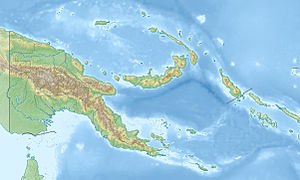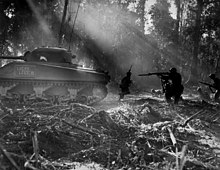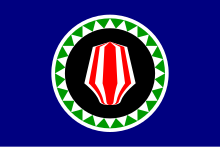bougainvillea
| bougainvillea | ||
|---|---|---|
| Map of the island | ||
| bodies of water | Pacific Ocean | |
| archipelago | Solomon Islands | |
| Geographical location | 6° 10′ S , 155° 15′ E | |
|
|
||
| length | 204 km | |
| broad | 64 km | |
| surface | 8th 800 km² | |
| highest elevation |
Mount Balbi 2715 m |
|
| resident | 249,358 (2011) 28 inhabitants/km² |
|
| Topographic Map | ||
Bougainville is an approximately 8800 km² island in the Pacific Ocean . Geographically (and with time zone UTC+11 ) it belongs to the archipelago of the Solomon Islands . Politically, together with the 500 km² neighboring island of Buka and some smaller islands, it forms the only autonomous region of Papua New Guinea ( Autonomous Region of Bougainville ).
The island was named after Louis Antoine de Bougainville . Partly because of Bougainville's remote location compared to the other provinces of Papua New Guinea, but above all against the background of a violent war over what was then the world's second largest copper and gold mine in Panguna , which cost between 15,000 and 20,000 victims, strong efforts for independence developed. In 2005 the first official elections for an autonomous provincial government took place. The Bougainville Revolutionary Army , victorious in 1997, was promised an independence referendum to be held from November 23 to December 7, 2019. 97.7% of the participants were in favor of complete independence. Current President Ishmael Toroama wants independence by 2025.
In 2011, 249,358 people lived in the province of Bougainville, which corresponds to a population density of almost 28 people per square kilometer. The administrative center of the island is Buka . It should be noted that the interior of the island is almost unpopulated.
geography
Geographically and ethnically, Bougainville and Buka are the northernmost islands of the Solomon Islands. By historical coincidence, they became part of the German colony of Deutsch-Neuguinea , eventually becoming part of the state of Papua New Guinea. On the west side of the island lies the Solomon Sea and mainland Papua New Guinea, on the east side the open Pacific Ocean. Bougainville is the easternmost province of Papua New Guinea and is separated from the main island by the sea and 750 km as the crow flies - while the nearest Solomon Islands is only eight kilometers away.
population
The inhabitants of Bougainville speak Austronesian , Papuan and, to a very small extent , Polynesian languages .
The particularly dark, almost black skin color of many Bougainvilleers is striking (English designation "black-skin" compared to "red-skin" for the other provinces of Papua New Guinea). With a few exceptions, the various population groups are organized along matrilineal lines. H. Land is inherited in the female line.
About 30 of the 830 languages of Papua New Guinea come from Bougainville, namely (cited by ethnologue ) Askopan, Bannoni, Hahon, Hakö, Halia , Koromira , Lantanai, Lawunuia, Naasioi , Nehan, Nukumanu , Nukuria (both Polynesian), Oune, Papapana , Petats, Ramopa, Rapoisi, Rotokas , Saposa, Sibe, Simeku , Siwai, Solos, Takuu (Polynesian), Teop , Terei, Tinputz , Torau , Uisai ( Wisai ), Uruava (Austronesian language, Southeast Bougainville, extinct).
business
With the Pangunamine , Bougainville had one of the world's largest open - pit copper mines from 1972 to 1989 , which for many years generated a large part of Papua New Guinea 's gross national product . The mining was operated by the Australian company Bougainville Copper (BLC), a subsidiary of the British-Australian mining company Rio Tinto /CRA, which controlled the company majority. The State of Papua New Guinea (PNG) has a 19.1% interest in Bougainville Copper.
As a result of the civil war and the forced closure of the mine by the rebels, Papua New Guinea's government revenues fell by 20%. Some hope for the possible reopening of the Panguna mine. Negotiations to reopen the Panguna mine began in early March 2006 with talks between former PNG Mines Minister Sam Akoitai and the Rio Tinto group in London. Some representatives of landowners in the Panguna area have repeatedly declared their willingness to resume mining operations, albeit in connection with demands for large compensation payments from the mine operator BCL.
In 2007, the yield from the two main export goods , cocoa and copra , returned to pre-civil war levels. Large-scale commercial plantations, largely run by Europeans, Asians, churches and corporations, which accounted for a significant portion of production before the civil war, are now used by smaller local operators. Further processing is carried out by small cocoa dryers supported by AusAid.
story
Pre-Colonial History
First traces of settlement can be proven for the time 28,000 years ago.
colonial era
Bougainville was first set foot in 1568 by a European, the Spanish captain Alvara de Mendana , who returned to the Solomon Islands in 1594 and died there. There was no contact with Europeans for almost two hundred years until French explorer Louis Antoine de Bougainville rediscovered the island in 1768. He was enthusiastic about the beauty of the island and its people and described both impressively. He also created a map of the island and named it after himself.
In 1886, Bougainville, along with other Solomon Islands, became part of the German protectorates in the South Pacific . The remaining Solomon Islands were later given to Britain in a trade, however Bougainville and Buka remained German (see 1899 Treaty of Samoa ) and formed part of German New Guinea . Even after the First World War , the island was not reunited with the British Solomon Islands in 1918 - contrary to the wishes of its chiefs - but remained part of the League of Nations mandate territory of New Guinea , which was transferred to Australia .
Second World War
During World War II , in March 1942, Japanese forces conquered the island and built some airports, which were then bombed by the United States armed forces . On November 1, 1943, the Allies began an offensive to conquer the island, which lasted until the surrender of the Japanese troops on September 8, 1945. From November 1944, Australian and New Zealand soldiers took over the offensive. At least 18,500 Japanese soldiers lost their lives. Allied losses were estimated at around 1,100 soldiers.
Papua New Guinea's independence in 1975
When Papua New Guinea became independent in 1975, there were timid desires for secession again . Indeed, on September 6, 1975, ten days before Papua New Guinea , Bougainville, under Alexis Sarei , proclaimed itself the Republic of the Northern Solomons . Prime Minister Somare declared this illegal. But it wasn't until demands from clans around the mine for compensation for environmental damage caused by the mine were denied that a serious conflict ensued: a group of villagers centered around Francis Ona , president of the Panguna Land Owners' Association in November 1988 the copper mine was shut down by acts of sabotage.
The Civil War ( The Crisis )
When the Bougainville Copper Mine was built, an arrangement was made whereby monthly gratuities were paid to the people of Bougainville. Of the portion of the company's dividends that went to the State of Papua New Guinea (PNG), only a fraction went back to Bougainville. Open pit mining continued to cause ecological damage. Bougainville Copper Ltd., in which PNG holds a 19.06% stake, was perceived by the public as a sign of PNG's oppression.
All of these factors led to severe tensions between sections of the population of Bougainville and the state of Papua New Guinea, and the subsequent formation of a rebel force.
The clans around the copper mine formed the Bougainville Revolutionary Army (BRA) and began resistance actions. They often used bows and arrows, home-made mines and guns - often made from old explosive bombs left behind during World War II. At first, the actions only consisted of blowing up the pylons supplying electricity to the copper mine. Ore mining came to a standstill repeatedly as a result. Buses carrying workers were attacked and workers killed.
In March 1989, the army was supposed to restore order. However, this failed and the conflict escalated.
Since the mine's power supply runs through long stretches of sparsely populated area and could therefore not be protected effectively, and both local and Australian mine personnel were threatened with their lives, Rio Tinto/CRA decided in 1989 to abandon the mine.
The civil war began largely unnoticed by the world public. It cost the lives of around 1,000 to 2,000 people over the next nine years. Another 15,000 people died as a result of a lack of medical care, caused by the naval blockade set up by Papua New Guinea a little later , which meant that urgently needed medicines were not available. The island of Bougainville then had a population of less than 200,000.
Because of the government army's bloody crackdown on civilians, the BRA managed to win large sections of the population over to their side. There were surprise victories for the BRA against the much better trained and armed government army, which withdrew from the island in March 1990.
The government now imposed a blockade on the island - food and medicines could only be smuggled into the island via the Solomon Islands - resulting in the deaths of several thousand civilians. During this phase, the BRA, which never had a unified political organization or structure, gambled away the sympathies of the population because individual groups acted out private conflicts under their cloak and violent attacks ensued. Resistance forces formed and supported the returning government army in 1992 in recapturing the island. During the crisis, many groups switched sides several times. Thus, in the massacre at Kangu Beach (English Kangu Beach ), Buin Resistance and BRA acted together against the New Guinean army . The army and various BRA and Resistance Force groups committed arbitrariness, torture and murder.
Terrorist acts continued to occur, and the Bougainville Interim Government was established as a political arm, with Francis Ona becoming its first president. Sam Kauona, an Australian-trained PNG Defense Force officer, defected to the BRA early on and became its highly successful commander. A means of communication – also for the leadership of the cell-like BRA – was Radio Free Bougainville , a pirate radio station whose reports could even be received in Australia by the local Bougainville Freedom Movement .
The Sandline Affair
In 1997, the Sandline Affair , an attempt to resolve the Bougainville conflict militarily, led to unrest that brought Papua New Guinea to the brink of a state crisis. Papua New Guinean Prime Minister Julius Chan enlisted the British-South African mercenary force Sandline International to break the BRA's resistance and retake the copper mine. As a result, large demonstrations against the foreign mercenary troops took place in the Papua New Guinean capital of Port Moresby , in which many government soldiers also took part. These demonstrations forced Chan to resign. The mercenaries were captured and expelled from the country by General Jerry Singirok. The new head of government, Bill Skate , immediately began negotiations with the rebel army, when they then defeated the Papua New Guinean army for the first time in an open field at Kangu Beach.
Autonomous Province
In October 1997 there was a ceasefire and spontaneous celebrations of joy and reconciliation by the population. An interim peace agreement was signed in New Zealand in January 1998 . This was followed in 2001 by the final peace agreement, in which Bougainville was declared an autonomous province within Papua New Guinea. On May 20, 2005, elections for an autonomous provincial government began for the first time. Winner of the elections and thus the first official President of the Autonomous Bougainville Government (English Autonomous Bougainville Government , ABG) was Joseph Kabui , a former companion of Francis Onas, who, however, had already distanced himself from this a few years earlier. For his part, Francis Ona had opposed the elections – Bougainville was already independent. According to the official version, Francis Ona died of malaria and typhus in July 2005 .
By 2020 at the latest, the population should decide on full independence in a referendum . A non-binding referendum on Bougainville's full independence was held from November 23 to December 7, 2019 . 176,928 of 181,067 participants (97.7%) were in favor of complete independence.
The copper mine is still closed and was in the hands of BRA rebel Francis Ona until his death. A lawsuit brought by him in San Francisco because of the environmental destruction still has to decide on the billions in compensation claims from the clans that own the land around the copper mine. However, this lawsuit is only given a small chance, especially since the jurisdiction of a US court is still in question.
Heads of government in Bougainville since the beginning of World War II
- 1942–1945 Hyakutake Seikichi , Japanese commander
- 1945 Kanda Masatane, Japanese commander
- 1943–1944 Oscar Woolverton Griswold , appointed by the United States
- 1944–1945 Sir Stanley George Savige, Australian Military Governor
- 1945–1975 Local people's governments without general representatives
- 1975-1980 Alexis Sarei; for the first time there was a provincial government and a president of the North Solomon Republic. The North Solomon Islands had an autonomous government.
- 1980–1984 Leo Hannett, governor of the autonomous province
- 1984-1987 Alexis Sarei, re-elected head of government of the autonomous province
- 1987–1990 Joseph Kabui , Governor of Autonomous Province
- 1990-1995 Sam Tulo, Administrator installed by the PNG government
- 1990–1998 Francis Ona, President of the Interim Government (rebel)
- 1995–1996 Theodore Miriung, President of the Provincial Government
- 1996-1998 Gerard Sinato, President of the Provincial Government
- 1999–1998 Gerard Sinato and Joseph Kabui, co-presidents of the Bougainville founding assembly
- 1999-2005 John Momis, special governor and then president of the provisional autonomous provincial government
- 2005–2005 Gerard Sinato, Provisional Governor by State Decree
- 2005–2008 Joseph Kabui , first president of the ABG autonomous government
- 2008–2010 James Tanis , second president of the autonomous government ABG
- 2010–2020 John Momis , third President of the ABG Autonomous Government
- Since 2020 Ishmael Toroama
literature
- Anthony Regan, Helga Griffin (eds.): Bougainville before the Conflict . Pandanus Books: Canberra 2005, ISBN 1-74076-138-3 .
- John Connell: Bougainville, the future of an island microstate. In: Journal of Pacific Studies. Volume 28, 2005, pp. 192-217. Link (PDF; 273 kB).
A literary portrait of the island during the civil war is provided by New Zealand author Lloyd Jones in his novel Mister Pip , which was shortlisted for the Booker Prize in 2007:
- Lloyd Jones: Mister Pip. Rowohlt, Reinbek bei Hamburg 2008, ISBN 978-3-498-03229-6 (Penguin Books, London 2007).
- Robert Young Pelton: Three Worlds Gone Mad: Dangerous Journeys through the war zones of Africa, Asia and the South Pacific. The Lyons Press: 2003, ISBN 978-1-59228-100-8 .
supporting documents
- ↑ bougainville-referendum.org
- ^ a b Bougainville's president seeks independence by 2025. In: RNZ . 19 May 2021, retrieved 22 May 2021 (English).
- ↑ Papua New Guinea: Provinces, Cities & Urban Settlements - Population Figures in Maps and Tables. Retrieved April 5, 2018 .
- ↑ Bibliographic Institute (ed.): Meyers Jahreslexikon 1975/76. What was important? 7/1/1975 – 6/30/1976. Meyers Lexikonverlag, ISBN 3-411-01365-6 , p. 99.
- ↑ B'ville referendum dates changed. 5 August 2019, retrieved 28 August 2019 (American English).
- ↑ Bougainville Votes for Papua New Guinea Independence , Deutschlandfunk, December 11, 2019.
- ↑ ABC: Bougainville votes overwhelmingly for independence from Papua New Guinea in landmark referendum , December 11, 2019 , accessed December 11, 2019.
- ↑ Momis declared Bougainville President
- ↑ Former rebel leader sworn in as President of Bougainville – derStandard.at. Retrieved October 17, 2020 (Austrian German).
web links
- Autonomous Government website







